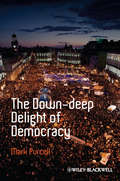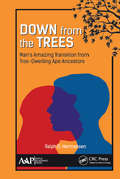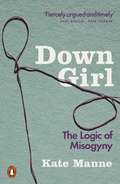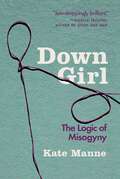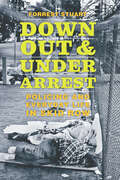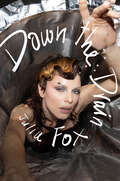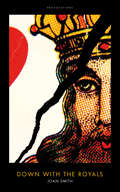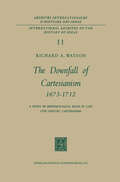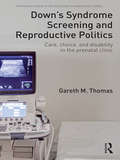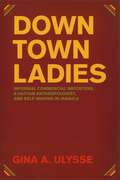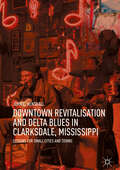- Table View
- List View
The Down-Deep Delight of Democracy (Antipode Book Series)
by Mark PurcellArguing that the hegemony of the neoliberal/capitalist nexus must be challenged if we are to address the proliferating challenges facing our world, this inspiring book explains how democracy can revive the political fortunes of the left. Explores issues central to the civil uprisings that swept the world in 2011, drawing profound connections between democracy and neoliberalism in an urban context Features in-depth analysis of key political theorists such as Gramsci; Lefebvre; Rancière; Deleuze and Guattari; and Hardt and Negri Advocates the reframing of democracy as a personal and collective struggle to discover the best in ourselves and others Includes empirical analysis of recent instances of collective action
Down from the Trees: Man’s Amazing Transition from Tree-Dwelling Ape Ancestors
by Ralph D. HermansenDown from the Trees: Man’s Amazing Transition from Tree-Dwelling Ape Ancestors covers the evolution of man from tree-dwelling ape to Homo sapiens as he is today. Using easy-to-read language, the author takes complex, jargon-filled material and extracts the essence of the topic and coveys it in a clear and engaging manner. He approaches the subject of human evolution from three different disciplines: fossil evidence and its interpretation, evolutionary theory and its applicability, and genetic evidence and its ability to unlock prehistoric information. The third discipline has advanced unbelievably in the last few years, and this book includes the most up-to-date research. There is nothing more interesting to humans than the story of their origins. The evolutionary process of a tree-dwelling ape becoming a walking, talking man who has developed the technology to walk on the moon, transplant hearts, or modify living things is no trivial story. This book provides a fascinating and comprehensive view of what science has learned of human evolution.
Down from the Trees: Man’s Amazing Transition from Tree-Dwelling Ape Ancestors
by Ralph D. HermansenDown from the Trees: Man’s Amazing Transition from Tree-Dwelling Ape Ancestors covers the evolution of man from tree-dwelling ape to Homo sapiens as he is today. Using easy-to-read language, the author takes complex, jargon-filled material and extracts the essence of the topic and coveys it in a clear and engaging manner. He approaches the subject of human evolution from three different disciplines: fossil evidence and its interpretation, evolutionary theory and its applicability, and genetic evidence and its ability to unlock prehistoric information. The third discipline has advanced unbelievably in the last few years, and this book includes the most up-to-date research. There is nothing more interesting to humans than the story of their origins. The evolutionary process of a tree-dwelling ape becoming a walking, talking man who has developed the technology to walk on the moon, transplant hearts, or modify living things is no trivial story. This book provides a fascinating and comprehensive view of what science has learned of human evolution.
Down Girl: The Logic of Misogyny
by Kate Manne'An important and compelling analysis of a phenomenon that's everywhere' Cordelia Fine, Big Issue'Offers a sharply cut prism through which to view our everyday experience' Afua Hirsch, The TLSA powerful, lucid analysis of the logic of misogyny from a remarkable feminist thinker, Down Girl is essential reading for the #MeToo era.Misogyny is a hot topic, yet it's often misunderstood. What is misogyny, exactly? Who deserves to be called a misogynist? How does misogyny contrast with sexism, and why is it prone to persist - or increase - even when sexist gender roles are waning? In Down Girl moral philosopher Kate Manne argues that misogyny should not be understood primarily in terms of the hatred or hostility some men feel toward all or most women. Rather, it is primarily about controlling, policing, punishing and exiling the "bad" women who challenge male dominance. And it is compatible with rewarding "the good ones" and singling out other women to serve as warnings to those who are out of order.
Down Girl: The Logic of Misogyny
by Kate ManneMisogyny is a hot topic, yet it's often misunderstood. What is misogyny, exactly? Who deserves to be called a misogynist? How does misogyny contrast with sexism, and why is it prone to persist - or increase - even when sexist gender roles are waning? This book is an exploration of misogyny in public life and politics by the moral philosopher and writer Kate Manne. It argues that misogyny should not be understood primarily in terms of the hatred or hostility some men feel toward all or most women. Rather, it's primarily about controlling, policing, punishing, and exiling the "bad" women who challenge male dominance. And it's compatible with rewarding "the good ones," and singling out other women to serve as warnings to those who are out of order. It's also common for women to serve as scapegoats, be burned as witches, and treated as pariahs. Manne examines recent and current events such as the Isla Vista killings by Elliot Rodger, the case of the convicted serial rapist Daniel Holtzclaw, who preyed on African-American women as a police officer in Oklahoma City, Rush Limbaugh's diatribe against Sandra Fluke, and the "misogyny speech" of Julia Gillard, then Prime Minister of Australia, which went viral on YouTube. The book shows how these events, among others, set the stage for the 2016 US presidential election. Not only was the misogyny leveled against Hillary Clinton predictable in both quantity and quality, Manne argues it was predictable that many people would be prepared to forgive and forget regarding Donald Trump's history of sexual assault and harassment. For this, Manne argues, is misogyny's oft-overlooked and equally pernicious underbelly: exonerating or showing "himpathy" for the comparatively privileged men who dominate, threaten, and silence women. l
Down Girl: The Logic of Misogyny
by Kate ManneMisogyny is a hot topic, yet it's often misunderstood. What is misogyny, exactly? Who deserves to be called a misogynist? How does misogyny contrast with sexism, and why is it prone to persist - or increase - even when sexist gender roles are waning? This book is an exploration of misogyny in public life and politics by the moral philosopher and writer Kate Manne. It argues that misogyny should not be understood primarily in terms of the hatred or hostility some men feel toward all or most women. Rather, it's primarily about controlling, policing, punishing, and exiling the "bad" women who challenge male dominance. And it's compatible with rewarding "the good ones," and singling out other women to serve as warnings to those who are out of order. It's also common for women to serve as scapegoats, be burned as witches, and treated as pariahs. Manne examines recent and current events such as the Isla Vista killings by Elliot Rodger, the case of the convicted serial rapist Daniel Holtzclaw, who preyed on African-American women as a police officer in Oklahoma City, Rush Limbaugh's diatribe against Sandra Fluke, and the "misogyny speech" of Julia Gillard, then Prime Minister of Australia, which went viral on YouTube. The book shows how these events, among others, set the stage for the 2016 US presidential election. Not only was the misogyny leveled against Hillary Clinton predictable in both quantity and quality, Manne argues it was predictable that many people would be prepared to forgive and forget regarding Donald Trump's history of sexual assault and harassment. For this, Manne argues, is misogyny's oft-overlooked and equally pernicious underbelly: exonerating or showing "himpathy" for the comparatively privileged men who dominate, threaten, and silence women. l
Down, Out, and Under Arrest: Policing and Everyday Life in Skid Row
by Forrest StuartIn his first year working in Los Angeles’s Skid Row, Forrest Stuart was stopped on the street by police fourteen times. Usually for doing little more than standing there. Juliette, a woman he met during that time, has been stopped by police well over one hundred times, arrested upward of sixty times, and has given up more than a year of her life serving week-long jail sentences. Her most common crime? Simply sitting on the sidewalk—an arrestable offense in LA. Why? What purpose did those arrests serve, for society or for Juliette? How did we reach a point where we’ve cut support for our poorest citizens, yet are spending ever more on policing and prisons? That’s the complicated, maddening story that Stuart tells in Down, Out and Under Arrest, a close-up look at the hows and whys of policing poverty in the contemporary United States. What emerges from Stuart’s years of fieldwork—not only with Skid Row residents, but with the police charged with managing them—is a tragedy built on mistakes and misplaced priorities more than on heroes and villains. He reveals a situation where a lot of people on both sides of this issue are genuinely trying to do the right thing, yet often come up short. Sometimes, in ways that do serious harm. At a time when distrust between police and the residents of disadvantaged neighborhoods has never been higher, Stuart’s book helps us see where we’ve gone wrong, and what steps we could take to begin to change the lives of our poorest citizens—and ultimately our society itself—for the better.
Down, Out, and Under Arrest: Policing and Everyday Life in Skid Row
by Forrest StuartIn his first year working in Los Angeles’s Skid Row, Forrest Stuart was stopped on the street by police fourteen times. Usually for doing little more than standing there. Juliette, a woman he met during that time, has been stopped by police well over one hundred times, arrested upward of sixty times, and has given up more than a year of her life serving week-long jail sentences. Her most common crime? Simply sitting on the sidewalk—an arrestable offense in LA. Why? What purpose did those arrests serve, for society or for Juliette? How did we reach a point where we’ve cut support for our poorest citizens, yet are spending ever more on policing and prisons? That’s the complicated, maddening story that Stuart tells in Down, Out and Under Arrest, a close-up look at the hows and whys of policing poverty in the contemporary United States. What emerges from Stuart’s years of fieldwork—not only with Skid Row residents, but with the police charged with managing them—is a tragedy built on mistakes and misplaced priorities more than on heroes and villains. He reveals a situation where a lot of people on both sides of this issue are genuinely trying to do the right thing, yet often come up short. Sometimes, in ways that do serious harm. At a time when distrust between police and the residents of disadvantaged neighborhoods has never been higher, Stuart’s book helps us see where we’ve gone wrong, and what steps we could take to begin to change the lives of our poorest citizens—and ultimately our society itself—for the better.
Down, Out, and Under Arrest: Policing and Everyday Life in Skid Row
by Forrest StuartIn his first year working in Los Angeles’s Skid Row, Forrest Stuart was stopped on the street by police fourteen times. Usually for doing little more than standing there. Juliette, a woman he met during that time, has been stopped by police well over one hundred times, arrested upward of sixty times, and has given up more than a year of her life serving week-long jail sentences. Her most common crime? Simply sitting on the sidewalk—an arrestable offense in LA. Why? What purpose did those arrests serve, for society or for Juliette? How did we reach a point where we’ve cut support for our poorest citizens, yet are spending ever more on policing and prisons? That’s the complicated, maddening story that Stuart tells in Down, Out and Under Arrest, a close-up look at the hows and whys of policing poverty in the contemporary United States. What emerges from Stuart’s years of fieldwork—not only with Skid Row residents, but with the police charged with managing them—is a tragedy built on mistakes and misplaced priorities more than on heroes and villains. He reveals a situation where a lot of people on both sides of this issue are genuinely trying to do the right thing, yet often come up short. Sometimes, in ways that do serious harm. At a time when distrust between police and the residents of disadvantaged neighborhoods has never been higher, Stuart’s book helps us see where we’ve gone wrong, and what steps we could take to begin to change the lives of our poorest citizens—and ultimately our society itself—for the better.
Down, Out, and Under Arrest: Policing and Everyday Life in Skid Row
by Forrest StuartIn his first year working in Los Angeles’s Skid Row, Forrest Stuart was stopped on the street by police fourteen times. Usually for doing little more than standing there. Juliette, a woman he met during that time, has been stopped by police well over one hundred times, arrested upward of sixty times, and has given up more than a year of her life serving week-long jail sentences. Her most common crime? Simply sitting on the sidewalk—an arrestable offense in LA. Why? What purpose did those arrests serve, for society or for Juliette? How did we reach a point where we’ve cut support for our poorest citizens, yet are spending ever more on policing and prisons? That’s the complicated, maddening story that Stuart tells in Down, Out and Under Arrest, a close-up look at the hows and whys of policing poverty in the contemporary United States. What emerges from Stuart’s years of fieldwork—not only with Skid Row residents, but with the police charged with managing them—is a tragedy built on mistakes and misplaced priorities more than on heroes and villains. He reveals a situation where a lot of people on both sides of this issue are genuinely trying to do the right thing, yet often come up short. Sometimes, in ways that do serious harm. At a time when distrust between police and the residents of disadvantaged neighborhoods has never been higher, Stuart’s book helps us see where we’ve gone wrong, and what steps we could take to begin to change the lives of our poorest citizens—and ultimately our society itself—for the better.
Down, Out, and Under Arrest: Policing and Everyday Life in Skid Row
by Forrest StuartIn his first year working in Los Angeles’s Skid Row, Forrest Stuart was stopped on the street by police fourteen times. Usually for doing little more than standing there. Juliette, a woman he met during that time, has been stopped by police well over one hundred times, arrested upward of sixty times, and has given up more than a year of her life serving week-long jail sentences. Her most common crime? Simply sitting on the sidewalk—an arrestable offense in LA. Why? What purpose did those arrests serve, for society or for Juliette? How did we reach a point where we’ve cut support for our poorest citizens, yet are spending ever more on policing and prisons? That’s the complicated, maddening story that Stuart tells in Down, Out and Under Arrest, a close-up look at the hows and whys of policing poverty in the contemporary United States. What emerges from Stuart’s years of fieldwork—not only with Skid Row residents, but with the police charged with managing them—is a tragedy built on mistakes and misplaced priorities more than on heroes and villains. He reveals a situation where a lot of people on both sides of this issue are genuinely trying to do the right thing, yet often come up short. Sometimes, in ways that do serious harm. At a time when distrust between police and the residents of disadvantaged neighborhoods has never been higher, Stuart’s book helps us see where we’ve gone wrong, and what steps we could take to begin to change the lives of our poorest citizens—and ultimately our society itself—for the better.
Down, Out, and Under Arrest: Policing and Everyday Life in Skid Row
by Forrest StuartIn his first year working in Los Angeles’s Skid Row, Forrest Stuart was stopped on the street by police fourteen times. Usually for doing little more than standing there. Juliette, a woman he met during that time, has been stopped by police well over one hundred times, arrested upward of sixty times, and has given up more than a year of her life serving week-long jail sentences. Her most common crime? Simply sitting on the sidewalk—an arrestable offense in LA. Why? What purpose did those arrests serve, for society or for Juliette? How did we reach a point where we’ve cut support for our poorest citizens, yet are spending ever more on policing and prisons? That’s the complicated, maddening story that Stuart tells in Down, Out and Under Arrest, a close-up look at the hows and whys of policing poverty in the contemporary United States. What emerges from Stuart’s years of fieldwork—not only with Skid Row residents, but with the police charged with managing them—is a tragedy built on mistakes and misplaced priorities more than on heroes and villains. He reveals a situation where a lot of people on both sides of this issue are genuinely trying to do the right thing, yet often come up short. Sometimes, in ways that do serious harm. At a time when distrust between police and the residents of disadvantaged neighborhoods has never been higher, Stuart’s book helps us see where we’ve gone wrong, and what steps we could take to begin to change the lives of our poorest citizens—and ultimately our society itself—for the better.
Down the Drain
by Julia FoxThe hotly anticipated book from ‘one of the all-time pop-culture greats’ (New York magazine) that chronicles her shocking life and unyielding determination to not only survive but achieve her dreams.
Down With the Royals: (Provocations)
by Joan SmithWhen Prince George was just eight weeks old, the Evening Standard declared him to be 'the most influential person in London'. He couldn't even walk, let alone talk. Yet one day he could become head of state, whether we like it or not. Joan Smith argues that it has become nearly impossible to question the existence of the monarchy. Articulate republicans are drowned out while the supercharged PR and media machines ask only who designed Kate's dresses. Smith topples the arguments for having a monarchy, one by one. The royals don't provide a boost for tourism, and their deliberately opaque accounting conceals the truth about the huge burden they place on the public purse. And she exposes darker truths. These symbols of so-called impartiality have hidden power and influence. Not only does Charles regularly lobby government ministers but - far from the sycophantic reporting of Kate's baby bump - the royals have dined with despots with blood on their hands. Are these people really fi t to be the public face of a modern country? Ultimately, Smith declares that the monarchy - undemocratic, unaccountable and shockingly expensive - has no place in modern Britain.
The Downfall of Cartesianism 1673–1712: A Study of Epistemological Issues in Late 17th Century Cartesianism (International Archives of the History of Ideas Archives internationales d'histoire des idées)
by R. A. WatsonDown's Syndrome Screening and Reproductive Politics: Care, Choice, and Disability in the Prenatal Clinic
by Gareth M. ThomasNominated for the Foundation of Sociology of Health and Illness Book Prize 2018 In the UK and beyond, Down’s syndrome screening has become a universal programme in prenatal care. But why does screening persist, particularly in light of research that highlights pregnant women’s ambivalent and problematic experiences with it? Drawing on an ethnography of Down’s syndrome screening in two UK clinics, Thomas explores how and why we are so invested in this practice and what effects this has on those involved. Informed by theoretical approaches that privilege the mundane and micro practices, discourses, materials, and rituals of everyday life, Down’s Syndrome Screening and Reproductive Politics describes the banal world of the clinic and, in particular, the professionals contained within it who are responsible for delivering this programme. In so doing, it illustrates how Down’s syndrome screening is ‘downgraded’ and subsequently stabilised as a ‘routine’ part of a pregnancy. Further, the book captures how this routinisation is deepened by a systematic, but subtle, framing of Down’s syndrome as a negative pregnancy outcome. By unpacking the complex relationships between professionals, parents, technology, policy, and clinical practice, Thomas identifies how and why screening is successfully routinised and how it is embroiled in both new and familiar debates surrounding pregnancy, ethics, choice, diagnosis, care, disability, and parenthood. The book will appeal to academics, students, and professionals interested in medical sociology, medical anthropology, science and technology studies (STS), bioethics, genetics, and/or disability studies.
Down's Syndrome Screening and Reproductive Politics: Care, Choice, and Disability in the Prenatal Clinic
by Gareth M. ThomasNominated for the Foundation of Sociology of Health and Illness Book Prize 2018 In the UK and beyond, Down’s syndrome screening has become a universal programme in prenatal care. But why does screening persist, particularly in light of research that highlights pregnant women’s ambivalent and problematic experiences with it? Drawing on an ethnography of Down’s syndrome screening in two UK clinics, Thomas explores how and why we are so invested in this practice and what effects this has on those involved. Informed by theoretical approaches that privilege the mundane and micro practices, discourses, materials, and rituals of everyday life, Down’s Syndrome Screening and Reproductive Politics describes the banal world of the clinic and, in particular, the professionals contained within it who are responsible for delivering this programme. In so doing, it illustrates how Down’s syndrome screening is ‘downgraded’ and subsequently stabilised as a ‘routine’ part of a pregnancy. Further, the book captures how this routinisation is deepened by a systematic, but subtle, framing of Down’s syndrome as a negative pregnancy outcome. By unpacking the complex relationships between professionals, parents, technology, policy, and clinical practice, Thomas identifies how and why screening is successfully routinised and how it is embroiled in both new and familiar debates surrounding pregnancy, ethics, choice, diagnosis, care, disability, and parenthood. The book will appeal to academics, students, and professionals interested in medical sociology, medical anthropology, science and technology studies (STS), bioethics, genetics, and/or disability studies.
The Downsizing of Asia
by François GodementUntil very recently it was assumed that the Asian miracle of prodigious economic growth would continue indefinitely. Europe and America, it seemed, were being left behind. The recent financial crisis in Asia has now changed all that.François Godement provides a broad-ranging survey of the regions economies since 1993 and explains the main reasons behind the recent financial crisis. He also examines important factors such as demography, Asian values, crony capitalism, industrial groupings and the wane of political authority.The Asian miracle has not come to an end, but the author makes clear that improved self-regulation and discipline within the financial sector will be crucial if the economies of the region are to weather the uncertainties of the marketplace in the future and realize their full potential.
The Downsizing of Asia
by François GodementUntil very recently it was assumed that the Asian miracle of prodigious economic growth would continue indefinitely. Europe and America, it seemed, were being left behind. The recent financial crisis in Asia has now changed all that.François Godement provides a broad-ranging survey of the regions economies since 1993 and explains the main reasons behind the recent financial crisis. He also examines important factors such as demography, Asian values, crony capitalism, industrial groupings and the wane of political authority.The Asian miracle has not come to an end, but the author makes clear that improved self-regulation and discipline within the financial sector will be crucial if the economies of the region are to weather the uncertainties of the marketplace in the future and realize their full potential.
Downtown America: A History of the Place and the People Who Made It (Historical Studies of Urban America)
by Alison IsenbergDowntown America was once the vibrant urban center romanticized in the Petula Clark song—a place where the lights were brighter, where people went to spend their money and forget their worries. But in the second half of the twentieth century, "downtown" became a shadow of its former self, succumbing to economic competition and commercial decline. And the death of Main Streets across the country came to be seen as sadly inexorable, like the passing of an aged loved one. Downtown America cuts beneath the archetypal story of downtown's rise and fall and offers a dynamic new story of urban development in the United States. Moving beyond conventional narratives, Alison Isenberg shows that downtown's trajectory was not dictated by inevitable free market forces or natural life-and-death cycles. Instead, it was the product of human actors—the contested creation of retailers, developers, government leaders, architects, and planners, as well as political activists, consumers, civic clubs, real estate appraisers, even postcard artists. Throughout the twentieth century, conflicts over downtown's mundane conditions—what it should look like and who should walk its streets—pointed to fundamental disagreements over American values. Isenberg reveals how the innovative efforts of these participants infused Main Street with its resonant symbolism, while still accounting for pervasive uncertainty and fears of decline. Readers of this work will find anything but a story of inevitability. Even some of the downtown's darkest moments—the Great Depression's collapse in land values, the rioting and looting of the 1960s, or abandonment and vacancy during the 1970s—illuminate how core cultural values have animated and intertwined with economic investment to reinvent the physical form and social experiences of urban commerce. Downtown America—its empty stores, revitalized marketplaces, and romanticized past—will never look quite the same again. A book that does away with our most clichéd approaches to urban studies, Downtown America will appeal to readers interested in the history of the United States and the mythology surrounding its most cherished institutions. A Choice Oustanding Academic Title. Winner of the 2005 Ellis W. Hawley Prize from the Organization of American Historians. Winner of the 2005 Lewis Mumford Prize for Best Book in American Planning History. Winner of the 2005 Historic Preservation Book Price from the University of Mary Washington Center for Historic Preservation. Named 2005 Honor Book from the New Jersey Council for the Humanities.
Downtown America: A History of the Place and the People Who Made It (Historical Studies of Urban America)
by Alison IsenbergDowntown America was once the vibrant urban center romanticized in the Petula Clark song—a place where the lights were brighter, where people went to spend their money and forget their worries. But in the second half of the twentieth century, "downtown" became a shadow of its former self, succumbing to economic competition and commercial decline. And the death of Main Streets across the country came to be seen as sadly inexorable, like the passing of an aged loved one. Downtown America cuts beneath the archetypal story of downtown's rise and fall and offers a dynamic new story of urban development in the United States. Moving beyond conventional narratives, Alison Isenberg shows that downtown's trajectory was not dictated by inevitable free market forces or natural life-and-death cycles. Instead, it was the product of human actors—the contested creation of retailers, developers, government leaders, architects, and planners, as well as political activists, consumers, civic clubs, real estate appraisers, even postcard artists. Throughout the twentieth century, conflicts over downtown's mundane conditions—what it should look like and who should walk its streets—pointed to fundamental disagreements over American values. Isenberg reveals how the innovative efforts of these participants infused Main Street with its resonant symbolism, while still accounting for pervasive uncertainty and fears of decline. Readers of this work will find anything but a story of inevitability. Even some of the downtown's darkest moments—the Great Depression's collapse in land values, the rioting and looting of the 1960s, or abandonment and vacancy during the 1970s—illuminate how core cultural values have animated and intertwined with economic investment to reinvent the physical form and social experiences of urban commerce. Downtown America—its empty stores, revitalized marketplaces, and romanticized past—will never look quite the same again. A book that does away with our most clichéd approaches to urban studies, Downtown America will appeal to readers interested in the history of the United States and the mythology surrounding its most cherished institutions. A Choice Oustanding Academic Title. Winner of the 2005 Ellis W. Hawley Prize from the Organization of American Historians. Winner of the 2005 Lewis Mumford Prize for Best Book in American Planning History. Winner of the 2005 Historic Preservation Book Price from the University of Mary Washington Center for Historic Preservation. Named 2005 Honor Book from the New Jersey Council for the Humanities.
Downtown Ladies: Informal Commercial Importers, a Haitian Anthropologist and Self-Making in Jamaica (Women in Culture and Society)
by Gina A. UlysseThe Caribbean “market woman” is ingrained in the popular imagination as the archetype of black womanhood in countries throughout the region. Challenging this stereotype and other outdated images of black women, Downtown Ladies offers a more complex picture by documenting the history of independent international traders—known as informal commercial importers, or ICIs—who travel abroad to import and export a vast array of consumer goods sold in the public markets of Kingston, Jamaica. Both by-products of and participants in globalization, ICIs operate on multiple levels and, since their emergence in the 1970s, have made significant contributions to the regional, national, and global economies. Gina Ulysse carefully explores how ICIs, determined to be self-employed, struggle with government regulation and other social tensions to negotiate their autonomy. Informing this story of self-fashioning with reflections on her own experience as a young Haitian anthropologist, Ulysse combines the study of political economy with the study of individual and collective identity to reveal the uneven consequences of disrupting traditional class, color, and gender codes in individual societies and around the world.
Downtown Ladies: Informal Commercial Importers, a Haitian Anthropologist and Self-Making in Jamaica (Women in Culture and Society)
by Gina A. UlysseThe Caribbean “market woman” is ingrained in the popular imagination as the archetype of black womanhood in countries throughout the region. Challenging this stereotype and other outdated images of black women, Downtown Ladies offers a more complex picture by documenting the history of independent international traders—known as informal commercial importers, or ICIs—who travel abroad to import and export a vast array of consumer goods sold in the public markets of Kingston, Jamaica. Both by-products of and participants in globalization, ICIs operate on multiple levels and, since their emergence in the 1970s, have made significant contributions to the regional, national, and global economies. Gina Ulysse carefully explores how ICIs, determined to be self-employed, struggle with government regulation and other social tensions to negotiate their autonomy. Informing this story of self-fashioning with reflections on her own experience as a young Haitian anthropologist, Ulysse combines the study of political economy with the study of individual and collective identity to reveal the uneven consequences of disrupting traditional class, color, and gender codes in individual societies and around the world.
Downtown Ladies: Informal Commercial Importers, a Haitian Anthropologist and Self-Making in Jamaica (Women in Culture and Society)
by Gina A. UlysseThe Caribbean “market woman” is ingrained in the popular imagination as the archetype of black womanhood in countries throughout the region. Challenging this stereotype and other outdated images of black women, Downtown Ladies offers a more complex picture by documenting the history of independent international traders—known as informal commercial importers, or ICIs—who travel abroad to import and export a vast array of consumer goods sold in the public markets of Kingston, Jamaica. Both by-products of and participants in globalization, ICIs operate on multiple levels and, since their emergence in the 1970s, have made significant contributions to the regional, national, and global economies. Gina Ulysse carefully explores how ICIs, determined to be self-employed, struggle with government regulation and other social tensions to negotiate their autonomy. Informing this story of self-fashioning with reflections on her own experience as a young Haitian anthropologist, Ulysse combines the study of political economy with the study of individual and collective identity to reveal the uneven consequences of disrupting traditional class, color, and gender codes in individual societies and around the world.
Downtown Revitalisation and Delta Blues in Clarksdale, Mississippi: Lessons for Small Cities and Towns
by John C. HenshallThis book is about Clarksdale, a small town in Mississippi, USA, and how the local community has revitalised the long-dilapidated downtown, with the renewal based on the town’s intimate association with Blues music and the culture that flows through the Mississippi Delta. John Henshall highlights underlying trends in downtown decline and revitalisation in cities and towns in America, together with commentary of his own experience at home in Australia.In Clarksdale, downtown economic revitalisation gained momentum in the mid-2000s as local residents and newcomers focused their entrepreneurial and creative efforts on promoting Clarksdale’s heritage, which is steeped in Blues music and Delta culture. While much attention to date has been given to large cities – from Sydney to San Francisco and from London to New York – as ‘creative cities’, little has been written about creativity in small cities and towns. This book delves into the positive role played by creative individuals in the economic revitalisation of downtown Clarksdale. The role of urban planning and community interaction is examined, and key lessons are provided for other small cities and towns, as they seek out opportunities to revitalise their downtowns and town centres.
